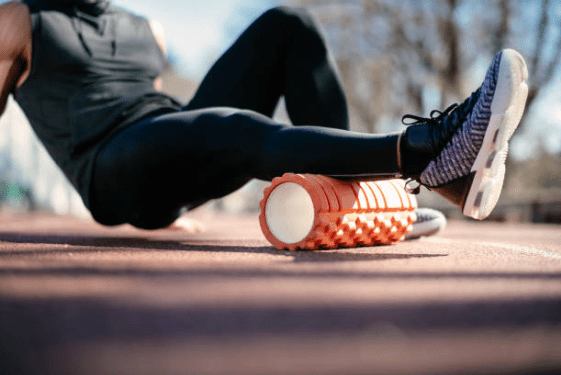There’s a lot of information out there about recovery strategies after exercise, and a lot of differing opinions from experts and amateurs alike on how to go about doing it. In this article, our sports medicine team will clear the air on some continued misconceptions about “tried and true” methods you might not realize are doing more harm than good, as well as discuss how to design the best plan of recovery for your training, not just a one-size-fits-all solution.
What is “Recovery” and Why is it Important After Exercise?
There are thousands of ways to move your body and exercise. Running, swimming, biking, hiking, weight lifting, rock climbing, dancing, HIIT, the list goes on (and on, and on.) Every type of exercise will usually have a typical warm-up routine, including dynamic stretching and a few light reps, but many athletes will finish their workout and then hop right into the shower, and completely ignore the crucial ending to their fitness routine: the Cool Down/Recovery.
Recovery after exercise helps prepare the muscles for eventually cooling down back to their baseline temperature and natural resting state. It also continues to improve blood circulation that helps remove waste product build-up from muscle tissue breakdown during exercise.
The period immediately following exercise is the best to take full advantage of your muscles’ heightened blood flow, temperature, and elasticity, which will help you avoid the dreaded Delayed Onset Muscle Soreness, or DOMS. If you don’t do anything to recover following exercise, you’re sacrificing a ton of the performance-enhancing benefits of the workout you just did, and potentially making yourself vulnerable to injury.
What About Lactic Acid Build-up? Isn’t That Why I’m Sore After Exercise?
The idea that lactic acid is responsible for DOMS was actually debunked all the way back in the 1980’s, even though it remains a pervasive myth in the fitness industry to this day. Lactate produced in muscle tissue during exercise is recycled into glucose and used as further fuel for your body. This means lactate actually helps delay muscle fatigue rather than cause it. More current research suggests DOMS is the result of microscopic tearing of the muscle fibers during exercise, which when given time to heal and recover, actually help the muscle adapt to getting stronger, faster, etc. That’s yet another reason why it’s crucial not to skimp on the post-workout recovery routine; so you can give your muscles their best chance to heal and adapt to make you an even better athlete the next time around.

What Recovery Strategies Are Out There?
There’s plenty we’re sure you’ve already heard of, and they belong to one of two categories: Passive Recovery and Active Recovery.
Some of the most popular passive recoveries are:
- Ice baths
- Cold Showers
- Hot/Cold Alternating therapy
- Sauna
Active recoveries include:
- Gradual cool-down at no more than 50% effort (light steady-state biking, walking, etc.)
- Yoga or Tai Chi
- Static stretching
- Foam rolling (myofascial release)
Which Strategies Should I Even Use? Or Not Use?
It’s important to experiment and see what works well with your body as well as keep in mind what exercise you’re doing, but one thing we will caution you against is jumping straight into an ice bath directly following exercise.
Some proponents of the ‘cold shock’ method, where you immerse your exercise-warmed body in a tub of extremely cold/icy water, as well as alternating hot/cold therapy swear by it. However, this can actually work against you and your goals in a few surprising ways.
Ice baths cause abrupt vasoconstriction in your muscle tissue, which means blood vessels get smaller, and drastically reduces blood flow; it also causes your muscles to contract and stiffen. Increased blood flow is how your body brings healing, rebuilding factors to injured tissue (remember those micro-tears exercise causes?) and also takes away waste materials from those areas. Just like how we don’t ice ankle sprains any more because we don’t want to interrupt the body’s natural healing process through inflammation. That increased blood flow in your musculature is critical for actually harnessing the full benefits of your exercise. Read more of Dr. Jow’s opinion on cold-based recovery on Nike.com
That’s not to say there’s never a time or place where ice baths are appropriate.
Say you’re playing in a soccer tournament, or any multi-day performance event and need the extra pain relief to be able to compete the next day. Once you’ve cooled down from your exercise and are back at baseline, an ice bath would absolutely be acceptable and even beneficial the night before you have another heavy, hard day of exercise for that extra bit of pain relief. However, we would not recommend taking ice baths after every single training session or practice to make sure that your body gets all the benefits from your exercise.
Heading into the sauna after exercising might feel relaxing, and it will be mentally, but in saunas you sit still, and hot, muggy air alone is not going to help your muscles slowly cool down to the point where you won’t be sore the next day, because the heat can’t penetrate that deeply.
If You Shouldn’t Just Ice Bath or Sauna Every Day After a Training Session, What Should You Do?
A combination of active recovery strategies is your best bet rather than just one.
We always recommend building a cool-down into your workout, whether that’s walking after running, or yoga in the gym. Following whatever cool down you do, some static stretching (at least 30 seconds) in each position is a great use of your muscles’ warmth and elasticity, but if you don’t have time for a full stretch session, foam rolling is another great way to help work out some of the post-exercise soreness.
For lighter exercise, using yoga as your cool-down/stretch could work, or perhaps a quick foam roll is all you have time for. The harder you exercise, the more recovery you’re likely to need, so it’s important to plan accordingly. If you only have an hour at the gym to do a hard workout, at least the last 15-20 minutes of that hour should be dedicated to recovery. For lighter days, maybe 10 minutes of stretching and foam rolling is enough. It all depends on you.
Our bodies have an amazing resiliency to adapt to and recover from exercise. Utilizing certain cool down techniques can take your performance to the next level by taking full advantage of the amazing adaptability of your muscles, and help keep you from needing more days off due to DOMS, or plateauing in your training. If you’re looking for a performance program llet the sports medicine specialists at Avid help you reach your goals. Our San Francisco sports medicine doctor can evaluate any pain or injuries that are holding you back and start your treatment on the same visit. Avid’s Athletic Trainers make a customized cross training and recovery program that’s right for you.
Co-author: Elizabeth Herron

